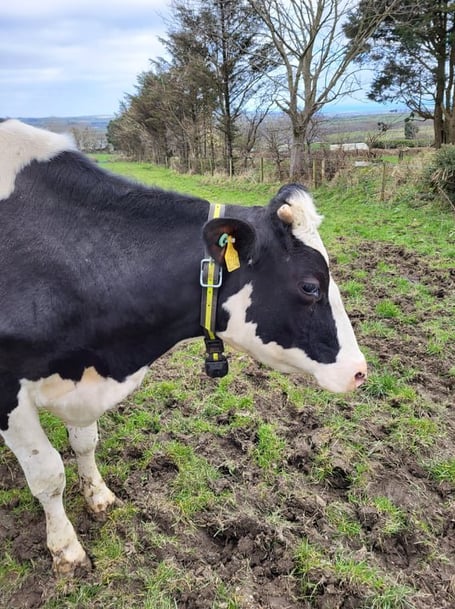How is your dairy cow feeling today? I mean, how is she really feeling? Is she feeding, ruminating – is she restless?
Vicky Sloane-Masson at Ballacricket Farm in Ronague simply turns on her mobile phone and checks an app to find out exactly how the family’s herd of 90 milking cows is faring.
They have been fitted with SenseHub collars which monitor their health and fertility, detecting cows in heat and measuring the resting, feeding, rumination, head position and restlessness of each animal, 24 hours a day.
This information is useful in a number of ways.
Vicky says: ‘The heat detector shows when a cow is bulling [ready to be served]. Some cows have silent heats so you never know when they’re in heat but with this you can tell.
‘It tells us the optimum time to serve with both conventional and sexed semen. Sexed semen is more sensitive so the timing is important.’
Scientifically speaking, sexed semen performs better when used around 18 hours after oestrus (peak heat), compared to about 12 hours for conventional semen. This optimal timing is what the monitoring collars can help to predict.
Vicky is one of many dairy farmers who are turning more and more to the use of sexed semen.
This is semen which has been identified as male or female through a scientific process using a fluoro dye that binds to the DNA. Dairy farmers have to plan their cow numbers carefully, according to factors such as the amount of grazing land they have on the farm, and don’t want to produce more than they need.
The used of sexed semen means they can breed premium female offspring to carry on the dairy herd, or they can use male sperm from a different breed to produce a beef-type calf.
Vicky has been collaborating with Chris Kneale, using Wagyu semen provided by Chris to inseminate some of her prize-winning Holstein dairy cows. When the calves are old enough, Chris takes them to rear on his farm in Jurby, to produce premium beef which sells to both local and off island outlets.
The monitoring collars are also useful to help cows get back to optimum health after calving.
Vicky says: ‘They are also giving us rumination data so if a cow has stopped ruminating we know. There is a graph so we can see what is normal and, when it takes dip on the graph, we can visually check her or take her temperature.
‘It means we are able to get cows fresh from calving back to full rumination as soon as possible.’
The SenseHub also alerts when a cow is in distress, most likely when she is calving. The first time it happened with the new collars was the evening Vicky and her husband Neil were out at the Southern Grassland Annual Dinner: ‘So we knew we had work to do when we got home!’ she says.
The monitoring can by done through a collar or an ear tag. Vicky has opted for collars and the cows seem quite happy to be wearing them, coming over to investigate us or getting on with their grazing. There is also a SenseHub system for monitoring cattle and another farmer in the island has just installed one of these.
You can find out more about cow monitoring at https://shop.allflex.co.uk/

.jpg?width=209&height=140&crop=209:145,smart&quality=75)
.png?width=209&height=140&crop=209:145,smart&quality=75)


Comments
This article has no comments yet. Be the first to leave a comment.